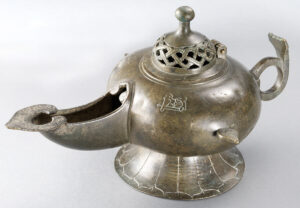
LNS 804 M
Bronze oil lamp with plait design, leaf spout and Kufic inscription ‘Blessing and happiness’
The al-Sabah Collection contains almost two thousand items of metalwork ranging from elaborately worked vessels inlaid with precious metals to simply cast bronze finials in the form of animals. Islamic metalworkers, whether in Cairo or Herat, often fashioned relatively simple forms covered the surface in dazzling engraved or precious metal-inlaid patterns of arabesque interlace, processions of animals or long benedictory inscriptions. Objects with calligraphy as decoration occur more frequently in metalwork than any other medium used for objects of utility. These range from benedictory inscriptions to verses from the Qur’an to lines of poetry, and sometimes include the signatures of the artists.
The ancient Near East has a long history of working in copper alloy and bronzes and brasses (copper alloyed with other metals) became the most important material in the pre-Islamic periods. Objects are almost invariably sculpturally powerful. In the hands of skilled artists, everyday objects such as oil lamps or incense burners became works of art. Brass was especially popular in the Mamluk domains. In the later period, especially in Iran and India, steel was used for decorative purposes; despite its hardness, it could be cut in openwork patterns, such as arabesques and calligraphic compositions as delicate as lace.

Bronze oil lamp with plait design, leaf spout and Kufic inscription ‘Blessing and happiness’
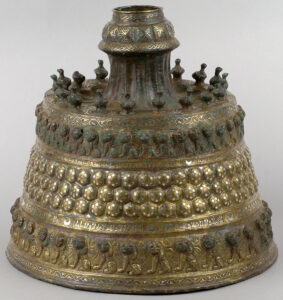
Bronze candlestick inlaid with copper and silver, with ducks, lions and Kufic invocations
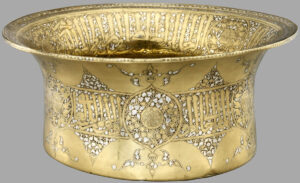
Brass basin inlaid with silver, thuluth inscriptions praising officer of al-Malik an-Nasir Muhammad
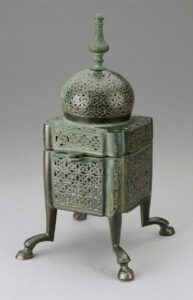
Bronze incense burner, domed body, quadruped feet, Kufic inscription blessing Abi Ishaq
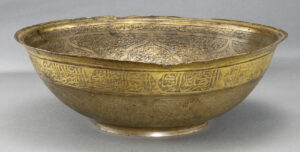
Parcel gilt bronze divining bowl with Qur’an passages, Shi‘a invocations, talismanic inscriptions
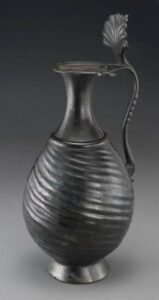
Bronze ewer with spirally ribbed body, palmette thumbrest and antelope-head base

Bronze reticulated lamp with riders, zodiac signs, planets and Kufic inscriptions
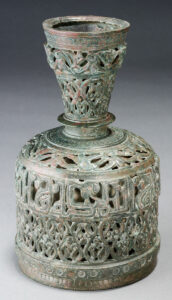
Bronze reticulated double-walled bottle with half-palmette scrolls and Kufic inscriptions
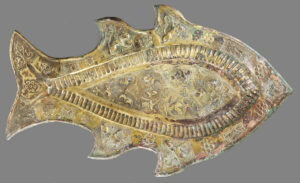
Bronze dish in the form of a fish, decorated with winged lions, hares and arabesques
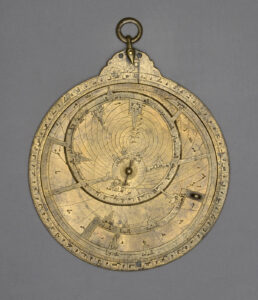
Brass astrolabe, earliest known Islamic example, signed by Nastulus, dated 315 AH

Bronze incense burner (lid missing) decorated with scrolling vines, handle finial poppy fruit
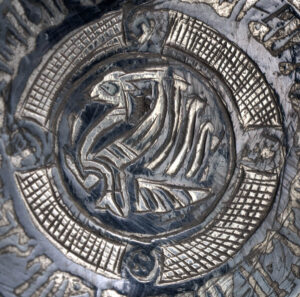
Silver folding spoon and fork with Kufic inscriptions, vegetal arabesques and simurghs
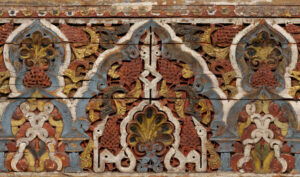
Objects of ivory and wood comprise decorative architectural items such as beams and doors, and smaller items such as boxes, jewellery and gaming pieces. Relatively few examples have survived due to the perishability of the materials.
That said, an ivory

The al-Sabah Collection contains almost two thousand items of metalwork ranging from elaborately worked vessels inlaid with precious metals to simply cast bronze finials in the form of animals. Islamic metalworkers, whether in Cairo or Herat, often fashioned relatively simple

With more than 12,000 coins in the collection, The al-Sabah Collections numismatic holdings are extensive. Coins in the collection were minted in virtually every corner of the geography of the Islamic world. Equally notable, they were minted over a period